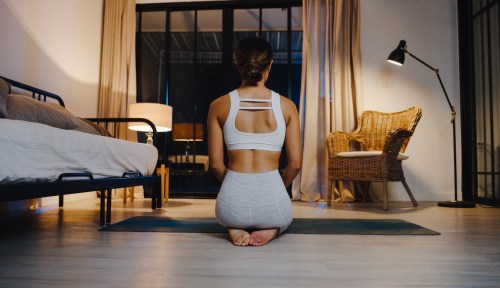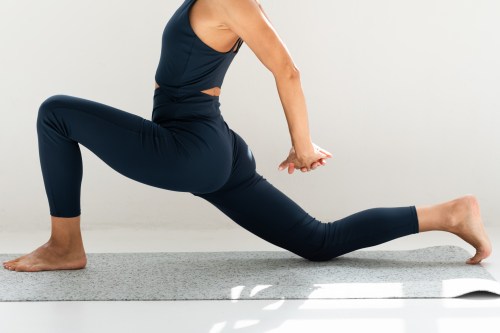Falling and staying asleep is one of my daily (er, nightly) struggles. I follow all of the typical expert advice: I have my bedtime routine down to a science, I turn off all my devices at least an hour or two before bed, I use a blue light blocker on all of my screens, I avoid caffeine, I get consistent exercise.
Experts in This Article
personal trainer and founder of the app Emily Skye FIT
naturopathic physician in Arizona
yoga instructor, health coach, and reiki master
One thing I’d never tried, though? Yoga for sleep. So when my editor asked if I would want to do five minutes of relaxing yoga poses before bed every night for two weeks to see what would happen, I was immediately game. Yoga lovers keep telling me that it’s calming for the body and mind, and since I seem to suffer from tension in both, I figured it might be a promising antidote to my sleep troubles.
Because even on the nights when I am able to fall asleep pretty quickly, I wake up countless times, and toss and turn for what seems like forever before finally falling back asleep. Either my mind starts racing with ideas of things I want to do the next day, or my body aches, making it too hard to relax.
So clearly, I was keen to see if bedtime yoga could live up to its promises to support my sleep, helping me fall asleep faster and stay asleep better.
What are the purported benefits of yoga for sleep?
Research has shown that yoga can help people with chronic insomnia to sleep better and that it can improve sleep quality in people 65 years and older in particular. That’s likely because it can ease stress and calm your nervous system.
And although many yogis swear by a morning yoga routine, Thara Natalie Prashad, a certified yoga teacher and health coach from the Institute of Integrative Nutrition, has told Well+Good that practicing restorative yoga before bed is a beneficial way to bring the body into a state of stillness: In addition to calming the nervous system, it brings circulation to the brain, and certain poses even produce serotonin and melatonin to promote better relaxation and sleep.
It can also just make us feel better physically, allowing our bodies to relax enough to nod off. “Yoga positions stretch long chains of muscles and fascia,” Sarah Trahan, NMD, a naturopathic physician in Arizona, has told Well+Good.
Also, “even a short slow flow style practice…is a way to let go of everything that is weighing you down before your head hits the pillow,” Emily Skye, founder of the app Emily Sky FIT, has pointed out to Well+Good. Adding a few yoga poses to your bedtime routine sets a marker between your day and night, helping you wind down not only physically, but also mentally, and let go of the day behind you.
The addition of deep breathing only helps to maximize all these relaxing benefits.
How I created a bedtime yoga routine
Although I enjoy most types of exercise, my primary wheelhouse is cardio, such as running, cycling, and rowing. I also do strength training in different forms and some stretching, yet my fitness routine doesn’t usually include yoga. To make sure I’d actually stick with this plan, I knew I’d have to keep any yoga routine quick.
And of course, I knew that a powerful, fast-paced vinyasa flow was not the ideal way to tap into yoga for insomnia. The best yoga for getting sleep is obviously something restorative. Rather than Warrior poses, I knew I should stick to a quick yoga routine that basically had me laying down (or close to it) the whole time.
I decided I’d do these seven relaxing yoga poses for better sleep:
- 1.Child’s pose: Sitting on your knees, lower your forehead to your mat, walk your finger tips forward, and send your weight into your heels.
- 2.Sphinx pose: Lying flat on your stomach, place your elbows under your shoulders and forearms flat on the floor, lifting up your upper body into a small backbend.
- 3.Pigeon pose: Starting in downward dog, bring one knee forward and place it behind the wrist on the same side, then inch the back leg backwards and lean your upper body forward over the front shin.
- 4.Legs up the wall pose: Lying on your back with your glutes next to a wall, rest your feet on the wall.
- 5.Cat-cow: From a hands-and-knees quadruped position, slowly arch the spine lifting the head, then contract and drop the head down.
- 6.Supine twist: Lying on your back with legs straight, bend one knee and bring it over your body to the opposite side and let it rest toward the floor while looking in the other direction.
- 7.Bridge pose: Lying on your back with feet flat on the floor, lift your hips up until there’s a straight line from your knees to your shoulders.
Just before getting into bed every night, I went through my yoga for insomnia series on the rug next to my bed with all of the lights off except for my illuminated wax melt machine and a nightlight. I held each for about 30 seconds, except for cat-cow, which I did for a full minute just because I like how it feels, and also because it seems like two poses in one. Instead of using a timer, I just counted my slow breaths. (The jarring sound of my alarm going off every 30 seconds didn’t seem like the most soothing lullaby.) Though, if one pose was feeling particularly good, I’d linger a bit. And I will fully admit that with my tight hips, pigeon pose probably got the short end of the stick most nights.
How bed yoga ended up affecting my sleep
The first night of my new yoga flow, I ended up having even more trouble than usual falling asleep. Not exactly what I was hoping for. I think that I’m such a creature of habit, that introducing a new element into my bedtime routine—particularly one that involves moving my body—kind of woke me up a bit from my drowsiness before bed.
Still, I’d committed to at least two weeks, so I decided to stick with it.
By the third night, I had my bed yoga routine down. And the opposite happened: My Oura ring showed that my “sleep latency,” or the time it took me to fall asleep, was only 11 minutes. Normally, that number is much closer to 30 or 35 minutes.
This trend continued, and my time to fall asleep is now averaging about 10 minutes per night. I have to admit, it’s quite shocking to me. I truly didn’t think that such a simple set of yoga poses could actually have that much of an impact on my sleep quality.
“My time to fall asleep is now averaging about 10 minutes per night.”
Unfortunately, I still wake up just as often during the night. But maybe the benefits I’ve seen in terms of how long it takes to fall asleep will eventually translate to helping me stay asleep?
I guess I’ll find out. Because while I might not become a regular at my local yoga studio anytime soon, I’m planning to keep up my new quick bedtime yoga routine. Five minutes of yoga to get to sleep 20 minutes faster? Worth it.
—reviewed by Angela Holliday-Bell, MD
Looking for a bedtime flow? Try this session designed to help you sleep:
Sign Up for Our Daily Newsletter
Get all the latest in wellness, trends, food, fitness, beauty, and more delivered right to your inbox.
Got it, you've been added to our email list.











